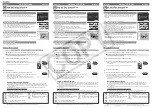
Windows Installer Editor Reference
155
Assembling an Installation
3. Complete the dialog box:
Use DIFxApp to install this driver file
When you mark this check box, the other options become enabled. They are all
marked by default.
Retain better-matching PnP function drivers
Mark this to retain the device’s Plug and Play function driver if it is a better
match for the device than the driver in the installation. If you clear this check
box, the installation’s plug and play function driver is always installed.
Prompt for missing device
Mark this to prompt the end user to connect a device to the computer if the
device matches this driver and is disconnected.
Create entry under Add/Remove Programs
Mark this to make this driver package removable through Add/Remove
Programs.
Driver Installation Order
This list box displays the .INF file you selected on the Files page and every other
.INF file in the installation that uses DIFxApp for its installation. Use the Move
Up and Move Down buttons to move the .INF file you selected on the Files page.
4. Click OK.
How Self-Registration Information is Captured
When you add a .DLL or .OCX file containing COM self-registration information to an
installation, its registration information is scanned and the appropriate registry keys are
added to the installation. This system of registration is more robust than letting the file
self-register at installation time because it does not depend on the presence of other
files on the destination computer or on how well the .OCX or .DLL file adheres to self-
registration conventions.
How self-registration information is scanned
z
When a file is added to an installation, its type libraries are scanned for registration
information and the appropriate registry keys are added to the installation. You can
set options in Wise Options to rescan and update the installation each time you
compile. Additional options determine whether the advertising information is added
to the advertising tables (AppId, Class, Extension, Mime, ProgId, TypeLib, Verb), to
the registry, or both.
See
Setting General Options
on page 38.
z
A more powerful scanning method captures information not available in the type
library, such as extensions, keys in hives other than HKEY_CLASSES_ROOT, and
keys in sections other than CLSID, Interface, Mime, Typelib, or ProgIds. To use this
method, do one of the following:
On the Component Details dialog box, mark Self-register the key path file
before compile. Each time you compile, files in the component are re-
registered, the registration information is rescanned, and any new information
is added to the installation.
See
Adding and Editing a Component
on page 425.
Use the WiseComCapture.exe utility to extract a file’s registration information to
a .REG file, from which you can import registry keys into the installation. Use
this method to avoid registering the files on your computer.
















































